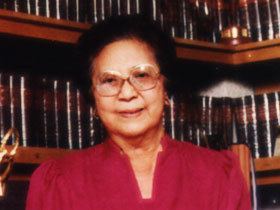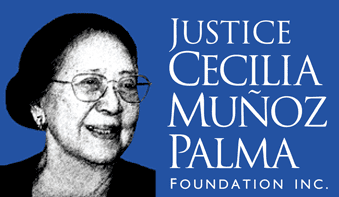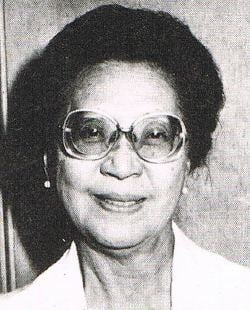Role Filipino Political figure Name Cecilia Munoz-Palma | Preceded by Newly created seat | |
Political party United Nationalist Democratic Organization (1984–1986) | ||
TODAY IN HISTORY - Philippine Jurist, Cecilia Muñoz Palma Remembered - 02 Jan 2011
Cecilia Muñoz-Palma (November 22, 1913 — January 2, 2006) was a Filipino jurist and the first woman appointed to the Supreme Court of the Philippines. She was appointed to the Supreme Court by President Ferdinand Marcos on October 29, 1973, and served until she reached the then-mandatory retirement age of 65.
Contents
- TODAY IN HISTORY Philippine Jurist Cecilia Muoz Palma Remembered 02 Jan 2011
- Background
- Dissenter from martial rule
- Opposition against Marcos
- 1986 Constitutional Commission and later life
- Legacy
- Some notable opinions
- References

While on the Court, Muñoz-Palma penned several opinions adverse to the martial law government of her appointer, President Marcos. After retiring from the Court, she became a leading figure in the political opposition against Marcos, and was elected to the Batasang Pambansa as an Assemblywoman from Quezon City. When Corazon Aquino was installed as President following the 1986 People Power Revolution, Muñoz-Palma was appointed chairwoman of the 1986 Constitutional Commission that drafted the 1987 Constitution.

Background
The daughter of a congressman from Batangas, Muñoz-Palma earned her law degree from the University of the Philippines College of Law, and a Master of Laws degree from Yale Law School. She topped the 1937 Philippine Bar exams with a 92.6% rating. She became the first woman prosecutor of Quezon City in 1947. Seven years later, she became the first female district judge when she was named a trial court judge for Negros Oriental. In the next few years, she was assigned as a judge to Laguna and Rizal until her appointment to the Court of Appeals in 1968, the second woman ever to be appointed to the appellate court. In 1973, she again made history, this time as the first female Supreme Court Associate Justice.
Dissenter from martial rule
By the time she retired from the Court in 1978, Muñoz-Palma had become identified, along with Claudio Teehankee, as a dissenter from rulings that affirmed the decrees and actions enforced by her appointer, President Ferdinand Marcos, during his martial law rule. As early as 1975, she had expressed skepticism that "a referendum under martial rule can be of no far-reaching significance as it is accomplished under an atmosphere or climate of fear." (Aquino v. COMELEC, G.R. No. L-40004, January 31, 1975, J. Muñoz-Palma, Separate Opinion ) The following year, she voted against allowing Marcos the right to propose amendments to the Constitution by himself, and in doing so, ventured to call for the lifting of martial law itself. In a later dissent, she added that "under a martial law regime there is, undeniably, repression of certain rights and freedoms, and any opinion expressed would not pass the test of a free and untrammeled expression of the will of the people. That "(M)artial law connotes power of the gun, meant coercion by the military, and compulsion and intimidation" was so stated by President Ferdinand E. Marcos upon proclamation of martial law in the country."
Opposition against Marcos
After her retirement from the Court, Muñoz-Palma emerged as a prominent figure in the anti-Marcos political opposition. In 1984, she was elected under the UNIDO banner to the Regular Batasang Pambansa as an Assemblywoman, representing Quezon City. She headed for a time a National Unification Council that sought to unify all anti-Marcos opposition groups. She also became an early supporter of the attempt to draft the then-reluctant Corazon Aquino to run for the presidency against Marcos.
1986 Constitutional Commission and later life
After Aquino assumed the presidency in 1986, Muñoz-Palma called in vain for the retention of the unicameral Batasang Pambansa as the country's legislative body but such plea was not heeded by the new President. Instead, the President dissolved it by means of a proclamation, which formed a provisional constitution that declares her government to be revolutionary and assumed legislative powers the now former Batasan held. When Aquino created the 1986 Constitutional Commission to draft the new Constitution, she appointed Muñoz-Palma as one of its members. The Commission would later elect her as its Chairwoman.

Following the ratification of the 1987 Constitution, Muñoz-Palma faded from the public eye. However, in 1998, she supported Vice-President Joseph Estrada for the presidency. After his election, President Estrada appointed the 85-year-old Muñoz-Palma as Chairperson of the Philippine Charity Sweepstakes Office. She served in this capacity until 2000. Muñoz-Palma strongly denounced the circumstances that led to Estrada's vacation of the presidency and the assumption into office of Gloria Macapagal-Arroyo.
Muñoz-Palma died on January 2, 2006, at the age of 92.
Legacy
Three years later, the International Women’s Forum inducted her into its International Hall of Fame. Her family and friends formed the Justice Cecilia Muñoz Palma Foundation to “continue what she started,” and will be launched on February 2009.
A street beside the City Hall of Manila was named in her memory. The City College of Manila also named a hall in her honor.
